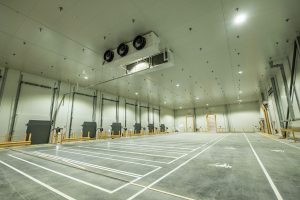Top Materials for Efficient Col Room Design
Cold rooms are essential in various industries, from food storage to pharmaceuticals, where temperature control is crucial for preserving the integrity of perishable goods. Efficient cold room design hinges on the selection of high-performance materials that enhance insulation, durability, and energy efficiency. This article explores the top materials used in cold room construction, focusing on their benefits and applications.
1. Importance of Material Selection in Cold Room Design
A. Energy Efficiency
One of the primary goals in cold room design is minimizing energy consumption. The right materials can significantly reduce heat transfer, helping maintain the desired temperature with less energy input. This not only lowers operational costs but also supports sustainability efforts.
B. Temperature Control
Maintaining a stable internal environment is crucial for the quality of stored products. Efficient materials contribute to consistent temperature management, preventing spoilage and ensuring compliance with industry regulations.
C. Durability and Longevity
Cold rooms are subjected to harsh conditions, including low temperatures and humidity. Therefore, selecting durable materials is vital for long-term performance and reduced maintenance costs.
2. Top Materials for Cold Room Construction
A. Insulation Materials
Insulation is perhaps the most critical component of cold room design. Effective insulation minimizes thermal bridging and maintains consistent internal temperatures. Key insulation materials include:
Polyurethane Foam: Known for its high R-value, polyurethane foam offers excellent thermal resistance. Its lightweight nature and superior air-sealing properties make it ideal for cold room applications.
Polystyrene: Available in both expanded (EPS) and extruded (XPS) forms, polystyrene provides decent insulation at a lower cost. It is moisture-resistant and often used for its affordability, though its R-value is generally lower than that of polyurethane.
Mineral Wool: This fire-resistant insulation is another option, providing decent thermal and acoustic properties. It is resistant to moisture and pests, making it suitable for cold storage environments.
B. Structural Materials
The structural integrity of a cold room is vital for safety and efficiency. Common structural materials include:
Steel: Steel is widely used for its strength and durability. It can support heavy loads and is resistant to corrosion, making it suitable for cold storage applications. Proper coating can enhance its resistance to moisture and cold.
Concrete: Reinforced concrete is often used for floors and walls. It provides a strong foundation and can be insulated to improve thermal performance. The thermal mass of concrete can help stabilize internal temperatures, reducing energy costs.

C. Wall and Ceiling Panels
The choice of panels for walls and ceilings plays a significant role in insulation and durability. Options include:
Metal Panels: Galvanized steel or aluminum panels are commonly used for their ease of cleaning and resistance to corrosion. When insulated, they provide effective thermal performance and longevity.
Structural Insulated Panels (SIPs): These pre-fabricated panels combine insulation with structural strength. SIPs reduce construction time and enhance energy efficiency, making them a popular choice for modern cold room designs.
3. Additional Considerations for Cold Room Design
A. Vapor Barriers
To prevent moisture buildup, vapor barriers are essential in cold room construction. Proper installation of vapor barriers helps protect insulation and maintain a stable environment, preventing condensation and potential mold growth.
B. Flooring Materials
Floors in cold storage facilities must be durable and resistant to moisture. Common flooring options include:
Epoxy Coatings: Epoxy provides a seamless, waterproof surface that is easy to clean and resistant to chemicals. Its durability makes it suitable for heavy traffic areas within cold rooms.
Polished Concrete: This option offers a hard, moisture-resistant surface that can withstand low temperatures. Sealing polished concrete can further enhance its resistance to cold and humidity.
C. Doors and Seals
Efficient doors and seals are crucial for maintaining temperature control. Considerations include:
Insulated Doors: Insulated doors help minimize heat transfer when entering or exiting the cold room. Options include sliding, swinging, and roll-up doors designed specifically for cold storage applications.
High-Quality Seals: Durable gaskets and seals prevent air leakage, which can compromise temperature stability and increase energy costs.
4. Sustainability in Cold Room Design
A. Eco-Friendly Materials
Sustainability is becoming increasingly important in cold room design. Eco-friendly material options include:
Recycled Insulation: Materials such as cellulose, made from recycled paper, provide effective insulation while minimizing environmental impact.
Sustainable Steel: Steel produced from recycled materials offers a reduced carbon footprint, contributing to greener building practices.
B. Energy-Efficient Systems
Incorporating energy-efficient refrigeration and lighting systems can significantly enhance the sustainability of cold storage facilities. Considerations include:
LED Lighting: Using LED lights reduces energy consumption and heat output, contributing to better temperature control and lower operational costs.
Smart Technology: Integrating smart energy management systems optimizes cooling processes, monitors energy use, and provides insights for improving efficiency.
5. Conclusion
Selecting the right materials for efficient cold room design is essential for ensuring energy efficiency, maintaining stable temperatures, and providing a durable storage environment for perishable goods. By carefully choosing insulation, structural components, panels, and additional materials, builders can create cold rooms that effectively preserve product quality while minimizing energy consumption. As sustainability becomes more critical, integrating eco-friendly materials and energy-efficient systems will further enhance the benefits of modern cold storage facilities. Understanding and implementing these top materials will lead to successful cold room solutions that meet the demands of various industries. Click this.

Recent Comments